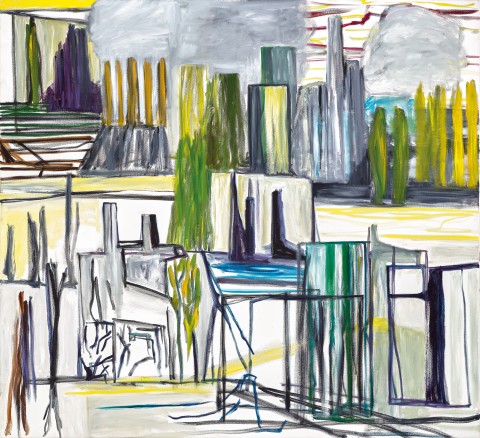CITYSCAPE/DEEP DREAM, 1994
KEN WHISSON
oil on canvas
110.0 x 120.0 cm
signed, dated and inscribed with title verso: Ken Whisson / Perugia 22/1/94 / + 16/2/94/ + 18/3/94 / Title: “Cityscape / Deep Dream”
Watters Gallery, Sydney (labels attached verso)
Private collection, Sydney, acquired from the above in 1997
Ken Whisson paintings & drawings, Watters Gallery, Sydney, 22 October – 8 November 1997, cat. 7 (illus. in exhibition catalogue)
By the time Ken Whisson came to paint Cityscape / Deep Dream, 1994, he had been living permanently in Italy for 17 years and settled into the rhythm of painting and sending the paintings back to Australia for annual solo exhibitions. During these years, the artist was at last comfortable and at ease with commercial and critical success. He was also able to travel abroad more freely and made the most of his annual trips to Australia. He would usually stay a couple of months and visit relatives and friends in most major cities, as well as making trips into the country. A look over the dates of many Whisson works reveals the European winter was a very productive time and it is no coincidence that these periods of high productivity followed his trips abroad. His memories and recollections from his time away would be perfect material for an artist who draws deeply on what he has seen, and how he now sees it.
The present work was painted between January and March 1994 following Whisson’s return to Italy. The upper area of the work appears to represent the vertical forms of a city, with details such as buildings, trees and chimneys represented by drapes of low-key colour. Two large clouds threaten to obliterate the sunrise. An abstracted subterranean world beneath presents an alternate perspective which appears open, airy and accessible. We are drawn into the interior of the city and feel the human scale of doors windows, walls and space. So, on one level we have the real experience of the entering the city as we fit into its domestic scale, and on another we have the imagined reality of the city, looming large, towering above.
There is a familiarity about Whisson’s landscapes for they are constructed of essential matter-of-fact fragments of memory that most of us share; trees are green, roads are grey and so are clouds. Cows have four legs and a tail, so do dogs – but cows are bigger. Birds have wings and fly up and around, they are hard to see because they move fast and blur when they fly. Of course, in reality the details of these examples are nuanced; no two greens or two trees or two cows are ever exactly the same, but their essential values in terms of form, patterns, mass and colour, which trigger memories are generally shared ones. In Whisson’s landscapes, everyday features become stylised versions of themselves. It is his ability to take these and add weight, mass and shape that creates the common denominator through which we view these paintings; it is what causes them to appear familiar and evocative. This is the level on which Whisson works; he is exploring the mechanics of memory, which is something we all share. An image of a particular tree for example can trigger memories, as far back as childhood, in an instant. A particular shade of colour can evoke an avalanche of recollection from a holiday, a place or an event. Once the door is open, memory floods the mind to create fragmented narratives, which Whisson presents as layers of colour, form and line. His completed paintings are a form of mental cubism.
Over a lifetime, Whisson quietly cemented his place in the canon of Australian painting. And until his sudden death at 94 in February this year, was painting daily with a fierce enthusiasm. The consistency of his output over many decades is unmatched and his often-polarising paintings are simply unique in Australian art. His 2012 retrospective exhibition held at Sydney’s Museum of Contemporary Art and the Heide Museum of Modern Art in Victoria, was a brilliant and uplifting testimony to his importance.
HENRY MULHOLLAND
